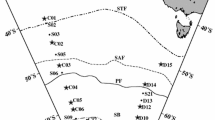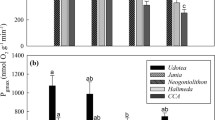Abstract
The ocean is a significant sink for increasing anthropogenic carbon dioxide emissions. The sea-surface microlayer (upper 50 μm layer) serves as the primary point for exchange of materials, including carbon dioxide, between the atmosphere and hydrosphere. We determined microalgal standing stocks and activities in microlayer and subsurface water from areas with (S) and without (NS) visible natural surface slicks in Sequim Bay, Washington, USA, in July 1984. Enrichment ratios (microlayer concentration: subsurface bulkwater concentration) were: phytoneuston population abundance, 37 (NS) to 154 (S); total chlorophylls, 1.3 (NS) to 18 (S); particulate carbon fixation, 2 (NS) to 52 (S); and dissolved carbon excretion, 17 (NS) to 63 (S). Photoinhibition of 36 to 89% occurred in phytoneuston under natural summer light-intensities. Slick samples had greater standing stocks and rates of primary production than non-slick samples. The species composition of phytoneuston was distinctly different from that of phytoplankton. These results suggest that phytoneuston form a unique community. Although carbon fixation in summer was less per individual in phytoneuston than in phytoplankton, because of their overall abundance at the air-sea interface, phytoneuston may play an important role in the transfer of CO2 from the atmosphere into ocean surface-water.
Similar content being viewed by others
Literature cited
Adam, N. K. (1937). A rapid method for determining the lowering of tension of exposed water surfaces with some observations on the surface tension of the sea and inland waters. Proc. R. Soc. (Ser. B) 122: 134–139
Albright, L. J. (1980). Photosynthetic activities of phytoneuston and phytoplankton. Can. J. Microbiol. 26: 389–392
Andrews, P., Williams, P. J. (1971). Heterotrophic utilization of organic compounds in the sea. III. Measurement of the oxidation rates and concentrations of glucose and amino acids in sea water. J. mar. biol. Ass. U.K. 51: 111–125
Baier, R. E., Goupil, D. W., Perlmutter, S., King, R. (1974). Dominant chemical composition of sea-surface films, natural slicks, and foams. J. Rech. Atmos. 8: 571–600
Bell, C. R., Albright, L. J. (1982). Bacteriological investigation of the neuston and plankton in the Frazer River estuary, British Columbia. Estuar., cstl Shelf Sci. 15: 385–394
Bezdek, H. F., Carlucci, A. F. (1972). Surface concentrations of marine bacteria. Limnol. Oceanogr. 17: 566–569
Bowes, G., Berry, J. A. (1972). The effect of oxygen on photosynthesis and glycolate excretion in Chlamydomonas reinhardtii. Yb. Carnegie Instn Wash. 71: 148–158
Brockmann, U. H., Kattner, G. Hentzschel, G., Wandschneider, K., Junge, H. D., Hühnerfuß, H. (1976). Naturliche Oberflächenfilme in Seegebiet vor Sylt. Mar. Biol. 36: 135–146
Campbell, S. A., Peterson, W. K., Postel, J. R. (1977). Phytoplankton production and standing stock in the main basin of Puget Sound. Final Rep. Municipality Metrop. Seattle p. 132
Carlson, D. J. (1982). Phytoplankton in marine surface microlayers. Can. J. Microbiol. 28: 1226–1234
Carlucci, A. F., Craven, D. B., Henrichs, S. M. (1985). Surface-film microheterotrophs: amino acid metabolism and solar radiation effects on their activities. Mar. Biol. 85: 13–22
De Souza Lima, Y., Chretiennot-Dinet, M. J. (1984). Measurements of biomass and activity of neustonic microorganisms. Estuar., cstl Shelf Sci. 19: 167–180
Dietz, A. S., Albright, L. J., Tuominen, T. (1976). Heterotrophic activities of bacterioneuston and bacterioplankton. Can. J. Microbiol. 22: 1699–1709
Fogg, G. E. (1966). The extracellular products of algae. Oceanogr. mar. Biol. A. Rev. 4: 195–212
Fogg, G. E. (1975). Biochemical pathways in unicellular plants. In: Cooper, J. P. (ed.) Photosynthesis and productivity in different environments. IBP 3. Cambridge University Press, New York, p. 437–457
Gallagher, J. L. (1975). The significance of the surface film in salt marsh plankton metabolism. Limnol. Oceanogr. 20: 120–123
Garrett, W. D. (1967). The organic chemical composition of the ocean surface. Deep-Sea Res. 14: 221–227
Goering, J. J., Menzel, D. W. (1965). The nutrient chemistry of the sea surface. Deep-Sea Res. 12: 839–843
Hardy, J. T. (1973). Phytoneuston ecology of a temperate marine lagoon. Limnol. Oceanogr. 18: 525–533
Hardy, J. T. (1982). The sea surface microlayer, biology, chemistry, and anthropogenic enrichment. Prog. Oceanogr. 11: 307–328
Hardy, J. T., Antrim, L. D. (1986). Refinement of methods for determining the toxicity of emissions from at-sea incinerators: evaluation of a microlayer sampler and toxicity tests at sea. Report on Contract 68-03-3319, WA 36-3 to U.S. Environmental Protection Agency, Washington, D.C.. Battelle Northwest Laboratories, Richland, Washington, D.C.
Hardy, J. T., Apts, C. W. (1984). The sea-surface microlayer: phytoneuston productivity and effects of atmospheric particulate matter. Mar. Biol. 82: 293–300
Hardy, J. T., Apts, C. W., Crecelius, E. A., Bloom, N. S. (1985). Sea-surface microlayer metal enrichments in an urban and rural bay. Estuar., cstl Shelf Sci. 20: 299–312
Hardy, J. T., Valett, M. K. (1981). Natural and microcosm phytoneuston communities of Sequim Bay, Washington. Estuar., cstl Shelf Sci. 12: 3–12
Harris, G. P. (1980). The measurement of photosynthesis in natural populations of phytoplankton. In: Morris, I., (ed.). The physiological ecology of phytoplankton. University of California Press Berkeley, Calif. 129–187
Hunter, K. A. (1980). Processes affecting particulate trace metals in the sea-surface microlayer. Mar. Chem. 9: 49–70
Iverson, R. L., Bittaker, H. F., Myers, V. B. (1976). Loss of radiocarbon in direct scintillation counting of solutions containing 14C-NaHCO3. Limnol. Oceanogr. 21: 756–758
Jeffrey, S. W., Humphrey, G. F. (1975). New spectrophotometric equations for determining chlorophylls a, b, c1, and c2 in higher plants, algae and natural phytoplankton. Biochem. Physiol. Pfl. 167: 191–194
Jensen, A. (1984). Excretion of organic carbon as a function of nutrient stress. In: Holm-Hansen, O., Bolis, L., Gilles, R. (eds.) Marine phytoplankton and productivity. Springer Verlag, New York, p. 61–72
Jokiel, P. L., York, R. H., Jr. (1984). Importance of ultraviolet radiation in photoinhibition of microalgae growth. Limnol. Oceanogr. 29: 192–199
Kjelleberg, S., Håkansson, N. (1977). Distribution of lipolytic, proteolytic, and amylolytic marine bacteria between the lipid film and the subsurface water. Mar. Biol. 39: 103–109
MacIntyre, F. (1974). The top millimeter of the ocean. Scient. Am. 230: 62–77
Mague, T. H., Friberg, E., Hughes, D. J., Morris, I. (1980). Extracellular release of carbon by marine phytoplankton; a physiological approach. Limnol. Oceanogr. 25: 262–279
Marumo, R., Nobuo, T., Nakai, T. (1971). Neustonic bacteria and phytoplankton in surface microlayers of the equatorial waters. Bull. Plankton Soc. Japan 18: 36–41
Meyers, P. A., Rice, C. P., Owen, R. M. (1983). Input and removal of natural and pollutant materials in the surface microlayer on Lake Michigan. Envir. Biogeochem. 35: 519–532
Nesterova, D. A. (1980). Phytoneuston in the Western Black Sea. Gidrobiol. Zh., Kiev. 16: 26–31
Norris, R. E. (1965). Neustonic marine Craspedomonodales (choanoflagellates) from Washington and California. J. Protozool 12: 589–602
Paerl, H. W., Bland, P. T., Bowles, N. D., Haibach, M. E. (1985). Adaptation to high light intensity, low-wavelength light among surface blooms of the cyanobacterium Microcystis aeruginosa. Appl. envirl Microbiol. 49: 1046–1052
Peterson, B. J. (1980). Aquatic primary productivity and the 14C−CO2 method. A. Rev. Ecol. Syst. 11: 359–385
Sharp, J. H. (1977). Excretion of organic matter by marine phytoplankton. Do healthy cells do it? Limnol. Oceanogr. 22: 381–399
Sieburth, J. (1971). Distribution and activity of oceanic bacteria. Deep-Sea Res. 18: 1111–1121
Sieburth, J., Willis, P. J., Johnson, K. M., Burney, C. M., Lavoie, D. M., Hinga, K. R., Caron, D. A., French, F. W., Johnson, P. W., Davis, P. G. (1976). Dissolved organic matter and heterotrophic microneuston in the surface microlayers of the North Atlantic. Science, N.Y. 194: 1415–1418
Smith, R. C., Baker, K. S. (1980). Stratospheric ozone, middle ultraviolet radiation, and carbon-14 measurements of marine productivity. Science, N.Y. 208: 592–593
Strickland, J. D. H., Parsons, T. R. (1972). A practical handbook of seawater analysis, 2nd ed. Bull. Fish. Res. Bd Can. 167: 1–310
Venrick, E. L. (1978). The implications of subsampling (5.1). How many cells to count? Statistical considerations (8.2). In: Sournia, A. (ed.) Phytoplankton manual. UNESCO, Paris, 1–337
Williams, P. J., Le B., Yentsch, C. S. (1976). An examination of photosynthetic production, excretion of photosynthetic products, and heterotrophic utilization of dissolved organic compounds with reference to results from a coastal subtropical sea. Mar. Biol. 35: 31–40
Williams, P. M. (1967). Sea-surface chemistry, organic carbon and inorganic nitrogen and phosphorus in surface films and subsurface waters. Deep-Sea Res. 14: 791–800
Williams, P. M., Carlucci, A. F., Henrichs, S. M., Van Vleet, E. S., Horrigan, S. G., Reid, F. M. H., and Robertson, K. J. (1986). Chemical and microbiological studies of sea-surface films in the southern Gulf of California and off the west coast of Baja California. Mar. Chem. 19: 17–98
Worrest, R. C., Brooker, D. L., Van Dyke, H. (1980). Result of a primary productivity study as affected by the type of glass in the culture bottles. Limnol. Oceanogr. 25: 360–364
Zaitsev, Y. P. (1971). Marine neustonology. [Transl. from Russ.]. National Marine Fisheries Service, NOAA and National Science Foundation. Springfield, Virginia
Author information
Authors and Affiliations
Additional information
Communicated by P. C. Schroeder, Pullman
Rights and permissions
About this article
Cite this article
Hardy, J.T., Apts, C.W. Photosynthetic carbon reduction: high rates in the sea-surface microlayer. Marine Biology 101, 411–417 (1989). https://doi.org/10.1007/BF00428138
Accepted:
Issue Date:
DOI: https://doi.org/10.1007/BF00428138




